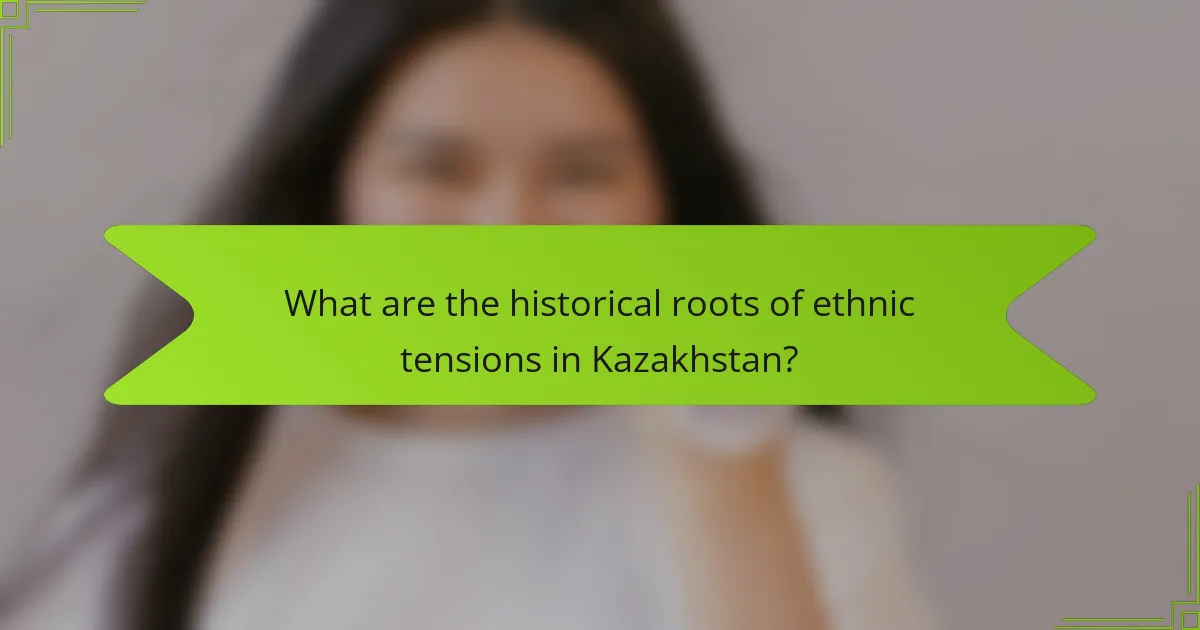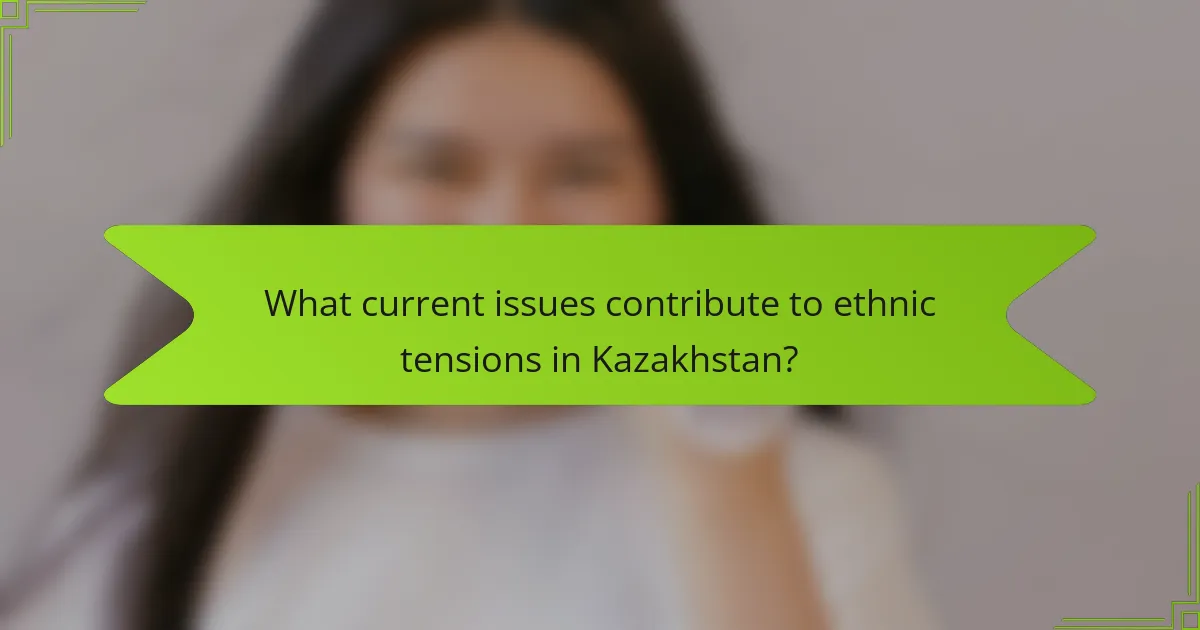Ethnic tensions in Kazakhstan are rooted in historical events from the Soviet era, including the forced relocation of various ethnic groups and policies that caused suffering among Kazakhs. Current issues such as economic disparities, political representation, and cultural differences continue to exacerbate these tensions. The government is actively working to address these challenges through initiatives promoting national unity, multiculturalism, and community engagement. Efforts include educational programs to foster tolerance, legal protections for minority rights, and targeted economic development in regions with diverse populations. This article explores the historical context, current issues, and resolution efforts related to ethnic tensions in Kazakhstan.

What are the historical roots of ethnic tensions in Kazakhstan?
Ethnic tensions in Kazakhstan have historical roots stemming from the Soviet era. The forced relocation of various ethnic groups, including Russians and Germans, significantly altered demographic balances. During the 1930s, policies of collectivization and repression led to mass suffering among Kazakhs. This created deep-seated grievances that persist today. Post-independence, the influx of ethnic Russians led to competition for resources and political power. Additionally, the unequal economic development of regions contributed to feelings of marginalization among ethnic Kazakhs. These historical events laid the groundwork for ongoing ethnic tensions in the country.
How did historical events shape ethnic identities in Kazakhstan?
Historical events significantly shaped ethnic identities in Kazakhstan. The Soviet era played a crucial role in this transformation. Policies of forced migration and collectivization altered demographic landscapes. For instance, the relocation of various ethnic groups, such as Russians and Ukrainians, impacted the cultural fabric. The 1937-1938 repression led to the persecution of Kazakh intellectuals, affecting national identity. Post-independence, Kazakhstan embraced a multi-ethnic identity, promoting harmony among groups. The 1991 independence allowed for the revival of Kazakh culture and language. Historical events thus created a complex interplay of identities, influencing contemporary ethnic relations.
What role did the Soviet era play in the development of ethnic tensions?
The Soviet era significantly contributed to the development of ethnic tensions in Kazakhstan. During this period, the Soviet government implemented policies that promoted Russification and suppressed local cultures. This led to the marginalization of ethnic Kazakhs and the promotion of Russian identity. The forced migration of various ethnic groups into Kazakhstan altered demographic balances. Ethnic Russians became a significant minority, leading to competition for resources and political power. Additionally, the Soviet Union’s central planning disregarded local needs, exacerbating tensions. These historical dynamics laid the groundwork for ongoing ethnic conflicts after the Soviet Union’s dissolution.
How have migration patterns influenced ethnic demographics in Kazakhstan?
Migration patterns have significantly influenced ethnic demographics in Kazakhstan. The Soviet era saw large-scale migration of ethnic Russians and other Slavic groups to Kazakhstan. This influx altered the ethnic balance, making ethnic Russians a substantial minority. Post-independence, many ethnic Russians migrated back to Russia, leading to a demographic shift. Currently, ethnic Kazakhs make up approximately 70% of the population. Meanwhile, the presence of ethnic minorities, including Russians and Uzbeks, remains notable. Migration policies and economic factors continue to shape these demographic dynamics today.
What are the key ethnic groups involved in tensions in Kazakhstan?
The key ethnic groups involved in tensions in Kazakhstan are Kazakhs, Russians, and Uighurs. Kazakhs are the largest ethnic group and have historical claims to the region. Russians are the second largest group and have a significant presence due to historical ties from the Soviet era. Uighurs, a Turkic ethnic group, have faced tensions related to cultural and political issues. Ethnic tensions often arise from competition for resources, political representation, and cultural recognition among these groups. Historical grievances and demographic shifts contribute to ongoing conflicts. The interplay of these factors creates a complex landscape of ethnic relations in Kazakhstan.
What are the characteristics and backgrounds of the major ethnic groups?
Kazakhstan’s major ethnic groups include Kazakhs, Russians, Uzbeks, Ukrainians, and others. Kazakhs are the largest group, comprising about 67% of the population. They have a nomadic heritage and a strong connection to the land. Russians make up approximately 20% and have a significant influence due to historical ties from the Soviet era. Uzbeks account for around 3% and have cultural roots linked to Central Asia. Ukrainians, while fewer in number, contribute to the diverse cultural tapestry of the country. Each group has distinct languages, traditions, and customs that reflect their unique histories. The coexistence of these groups shapes Kazakhstan’s social dynamics and ethnic relations.
How do the cultural differences between these groups contribute to tensions?
Cultural differences between ethnic groups in Kazakhstan contribute to tensions through various factors. These include language barriers, differing traditions, and contrasting social norms. Language differences can lead to miscommunication and feelings of exclusion. For instance, ethnic Kazakhs primarily speak Kazakh, while ethnic Russians often use Russian. This can create divisions in education and public services.
Differing traditions can result in misunderstandings. Ethnic groups may have unique customs that others perceive as unfamiliar or threatening. For example, celebrations and rituals may clash, leading to social friction. Contrasting social norms can also cause tensions. Different perceptions of authority, family roles, and community responsibilities can lead to conflicts.
Historical grievances further exacerbate these tensions. Past policies and events have fostered mistrust among groups. For example, the Soviet era’s forced relocations and cultural suppression have left lasting scars. These historical contexts shape current interactions and perceptions.
Overall, these cultural differences manifest in everyday interactions, influencing social cohesion and contributing to ongoing tensions.

What current issues contribute to ethnic tensions in Kazakhstan?
Current issues contributing to ethnic tensions in Kazakhstan include economic disparities, political representation, and cultural differences. Economic disparities exist between ethnic Kazakhs and minority groups, impacting access to resources. Political representation is often skewed, with ethnic Kazakhs holding dominant positions in government. This creates feelings of marginalization among minority ethnic groups, such as Russians and Uighurs. Cultural differences can lead to misunderstandings and conflicts over language and education policies. Additionally, recent protests have highlighted grievances related to social inequality and governance, exacerbating ethnic tensions. These factors collectively create a volatile environment, influencing inter-ethnic relations in the country.
How do socio-economic factors influence ethnic relations?
Socio-economic factors significantly influence ethnic relations by shaping access to resources and opportunities. Disparities in wealth and employment can lead to competition among ethnic groups. For instance, in Kazakhstan, economic inequality has historically exacerbated tensions between ethnic Kazakhs and ethnic Russians. Limited access to education and healthcare can deepen divisions. When one ethnic group feels marginalized economically, it may foster resentment towards others. Research indicates that socio-economic integration promotes harmony among diverse groups. The World Bank reported that inclusive economic policies can enhance social cohesion. Thus, socio-economic factors play a crucial role in either mitigating or escalating ethnic relations.
What disparities exist in economic opportunities among different ethnic groups?
Disparities in economic opportunities among different ethnic groups in Kazakhstan are significant. Ethnic Kazakhs generally have better access to resources and government support. In contrast, ethnic minorities, such as Russians and Uighurs, often face barriers in employment and business. According to a 2020 report by the World Bank, ethnic minorities experience higher unemployment rates. Furthermore, access to education and training programs is often limited for these groups. Research indicates that systemic discrimination affects their economic mobility. Historical policies have favored ethnic Kazakhs, leading to wealth concentration among them. These disparities contribute to ongoing ethnic tensions in the country.
How does access to education and healthcare vary by ethnicity?
Access to education and healthcare in Kazakhstan varies significantly by ethnicity. Ethnic minorities often face barriers to quality education and healthcare services. For instance, Kazakhstani ethnic Russians may have limited access to education in their native language. This can hinder their academic performance and integration. Additionally, ethnic minorities may experience disparities in healthcare access. They often reside in rural areas with fewer medical facilities. According to the Kazakhstan National Statistics Agency, ethnic minorities report lower satisfaction with healthcare services. This situation reflects broader systemic inequalities within the country. The government has initiated programs to address these disparities, but challenges remain.
What political dynamics are at play in ethnic tensions in Kazakhstan?
Ethnic tensions in Kazakhstan are influenced by a complex interplay of political dynamics. The government’s policies favoring the ethnic Kazakh majority often marginalize minority groups. This creates feelings of disenfranchisement among ethnic Russians and other minorities. Additionally, regional disparities in economic development exacerbate these tensions. Areas with significant minority populations often experience higher unemployment and lower investment. Political representation is also skewed, leading to a lack of voice for ethnic minorities in governance. Historical grievances from the Soviet era continue to affect interethnic relations. The rise of nationalism among ethnic Kazakhs further complicates the political landscape. Overall, these dynamics contribute to an environment of tension and potential conflict.
How do government policies affect ethnic group relations?
Government policies significantly influence ethnic group relations. Policies can promote inclusion or exacerbate tensions. For example, affirmative action in Kazakhstan aimed to support minority groups. This policy fostered a sense of belonging among ethnic minorities. Conversely, restrictive language laws can marginalize certain groups. Such laws may lead to feelings of alienation and resentment. Historical events, like the Soviet-era policies, have lasting impacts on ethnic interactions. Current policies shape the social landscape and affect community cohesion. Overall, government actions play a crucial role in either bridging or widening ethnic divides.
What role does representation in government play in mitigating or exacerbating tensions?
Representation in government plays a critical role in mitigating or exacerbating tensions. When diverse groups are represented, it fosters inclusivity and trust among communities. This representation can lead to policies that address the specific needs of various ethnic groups. For example, in Kazakhstan, inclusive governance has been linked to reduced ethnic tensions. Conversely, lack of representation can lead to feelings of marginalization. Marginalized groups may feel their interests are ignored, leading to increased tensions. Historical instances in Kazakhstan show that underrepresentation has often resulted in conflict. Thus, effective representation is essential for social cohesion and stability.

What efforts are being made to resolve ethnic tensions in Kazakhstan?
The government of Kazakhstan is implementing various efforts to resolve ethnic tensions. These include promoting national unity through policies that encourage multiculturalism. Programs aimed at fostering dialogue among different ethnic groups are being established. Educational initiatives are also in place to teach tolerance and respect for diversity. The government is facilitating community engagement through cultural events and forums. Additionally, legal frameworks are being strengthened to protect minority rights. Economic development projects are targeting regions with ethnic diversity to promote equitable growth. These efforts aim to create a cohesive society and mitigate conflicts.
How effective are current conflict resolution strategies?
Current conflict resolution strategies in Kazakhstan are moderately effective. These strategies often incorporate dialogue, mediation, and community engagement. Historical grievances and ethnic divisions complicate their success. Research indicates that inclusive approaches yield better outcomes. A study by the International Crisis Group highlights the importance of addressing underlying tensions. Effective strategies also require the involvement of local leaders. Ongoing training for mediators is essential for improved results. Overall, while progress is evident, challenges remain in fully resolving ethnic tensions.
What initiatives have been implemented to promote interethnic dialogue?
Various initiatives have been implemented to promote interethnic dialogue in Kazakhstan. The government has established the Assembly of People of Kazakhstan. This body facilitates communication between different ethnic groups. It organizes cultural events and forums to foster understanding. Educational programs have also been introduced in schools. These programs focus on teaching tolerance and respect for diversity. Community projects encourage collaboration among ethnic groups. They aim to build trust and cooperation. Research indicates that these initiatives have led to improved relations among communities.
How do grassroots movements contribute to reconciliation efforts?
Grassroots movements contribute to reconciliation efforts by fostering community engagement and dialogue. They empower marginalized voices and promote understanding among diverse groups. These movements often address historical grievances, which is crucial in post-conflict societies. In Kazakhstan, grassroots initiatives have facilitated discussions on ethnic identity and shared history. For example, local organizations have organized forums that bring together different ethnic communities. This approach helps build trust and reduces tensions. Additionally, grassroots movements often advocate for policy changes that support inclusivity. Their efforts can lead to more equitable resource distribution, further promoting harmony. Overall, grassroots movements play a vital role in creating a foundation for lasting reconciliation.
What lessons can be learned from Kazakhstan’s approach to ethnic tensions?
Kazakhstan’s approach to ethnic tensions teaches the importance of inclusive governance. The country implements policies promoting ethnic harmony among its diverse population. This includes recognizing multiple languages and cultures in official settings. Kazakhstan also emphasizes economic development in ethnically diverse regions. This strategy reduces grievances and fosters cooperation. By promoting dialogue between ethnic groups, the government enhances social cohesion. Historical examples show that proactive measures can prevent conflicts. Kazakhstan’s experience illustrates that addressing underlying issues is crucial for stability.
What best practices can be applied to similar contexts globally?
Promoting inclusive governance is a best practice applicable globally to contexts of ethnic tension. This involves ensuring representation of diverse ethnic groups in decision-making processes. It fosters trust and reduces grievances among communities. Implementing conflict resolution mechanisms is also crucial. These mechanisms should be culturally sensitive and accessible. Education programs that promote intercultural understanding can mitigate tensions. Research shows that countries with strong educational initiatives experience lower ethnic conflicts. Encouraging dialogue between communities builds relationships and reduces stereotypes. Establishing economic opportunities for all ethnic groups can address underlying inequalities. These practices collectively create a more harmonious society.
How can community engagement foster peace among diverse ethnic groups?
Community engagement can foster peace among diverse ethnic groups by promoting dialogue and understanding. It creates spaces for individuals to share their experiences and perspectives. Such interactions can reduce stereotypes and misconceptions. Collaborative projects encourage teamwork and shared goals. These initiatives build trust and relationships among community members. Research shows that inclusive community efforts lead to lower conflict rates. For example, the United Nations Development Programme highlights successful case studies in conflict resolution through community engagement. Therefore, fostering peace requires active participation and collaboration among different ethnic groups.
The article focuses on the entity of ethnic tensions in Kazakhstan, exploring their historical roots, current issues, and resolution efforts. It outlines how Soviet-era policies, forced migrations, and economic disparities have shaped ethnic identities and contributed to ongoing conflicts among key groups, including Kazakhs, Russians, and Uighurs. The discussion includes the impact of socio-economic factors, political dynamics, and cultural differences on inter-ethnic relations, as well as the government’s initiatives to foster dialogue and promote inclusivity. Additionally, it highlights the role of grassroots movements and best practices for addressing ethnic tensions in similar contexts globally.